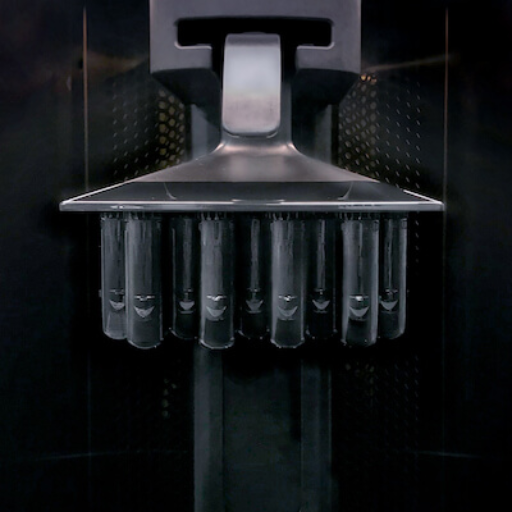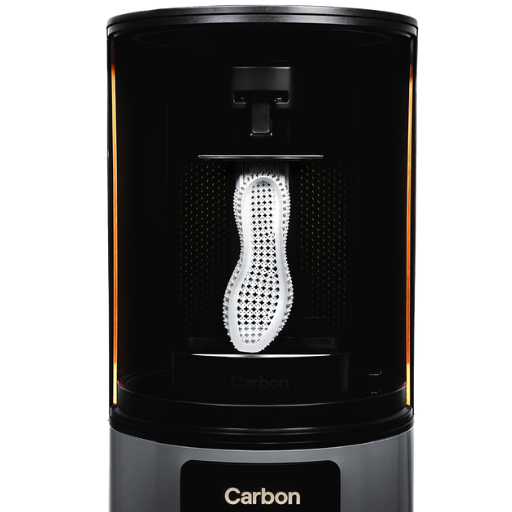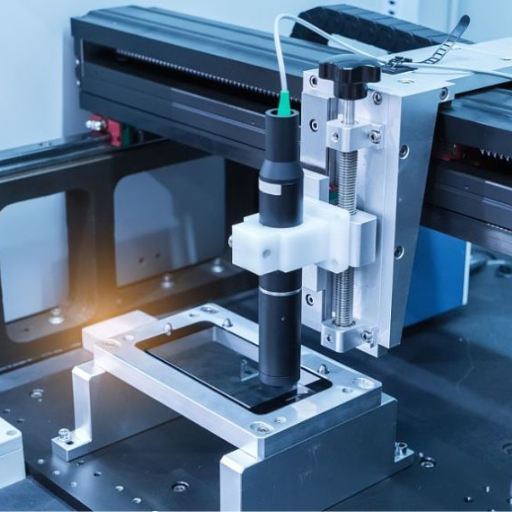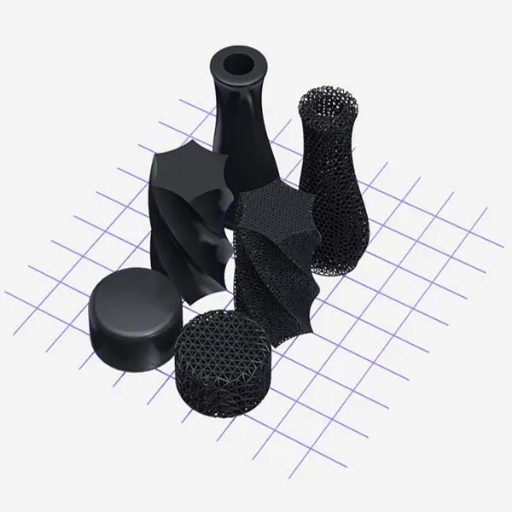To keep up with changing models in manufacturing, it is essential to adopt modern technologies that change the dynamics of production. Carbon DLS (Digital Light Synthesis) is an innovative 3D printing technology that is set to redefine the way industries create and manufacture parts. This blog takes a deeper look into Carbon DLS technology’s numerous benefits showcasing its matchless accuracy, scalability, and material flexibility. Through instances of practice or triumph stories, this blog can be used as a partial guide on how Carbon DLS has transformed manufacturing by offering improved performance and efficiency resulting in more productive sectors which are driven by innovation.
What is Carbon Digital Light Synthesis™ (DLS) 3D Printing?

Image source: https://www.rpm-factories.de/
Carbon Digital Light Synthesis™ (DLS) 3D Printing is an advanced manufacturing technology that uses light and oxygen to produce high-quality, end-use products from liquid resins. Carbon DLS 3D printing differs from traditional layer-by-layer methods in that it employs a digital projector to create a continuous series of UV images for solidifying a photopolymerizable resin into an object. This method facilitates quick fabrication of complex parts with smoother surfaces and more intricate features suitable for highly accurate applications. It delivers therefore a flexible and scalable approach that can meet the different requirements of today’s manufacturing.
Introduction to Carbon DLS 3D Printing
Carbon Digital Light Synthesis™ (DLS) 3D Printing is an innovative technology that alters the manufacturing system by merging traditional manufacturing’s strong points with the flexibility of 3D printing. Traditional methods of 3D printing build objects layer by layer, but in contrast to this, Carbon DLS utilizes a continuous liquid interface production (CLIP) process. In this technique, photopolymerizable resins are cured by light coming from a digital light projector at a very high rate leading to products with excellent mechanical properties and surface finish at much higher speeds than conventional 3-D printers do. The benefit is in its ability to produce isotropic parts; this means that it causes uniform properties in all directions due to the integration between light and oxygen during curing. Therefore, when dental and medical devices, automotive components or even consumer goods industries are mentioned as examples; such industries use Carbon DLS for high precision parts thus better prototyping rapidly and low volume production efficiently and quality wise beyond doubt become possible.
How Does Digital Light Synthesis Process Work?
It starts with a pool of liquid resin. A digital light projector shines UV images through an oxygen-permeable window at the bottom of the resin pool. The resin solidifies due to ultraviolet (UV) light that cures it in layers, while oxygen retards curing at the interface in a controlled manner. Rather than discrete layers as used in conventional 3D printing, this allows for continuous and smooth building up of the object. Such combination of control over light and oxygen results in isotropic parts with consistent mechanical properties in all directions Once the object is fully formed, it is taken out from the resin pool and subjected to post-processing such as baking which help improve its mechanical properties for durability.
Advantages of Using Carbon DLS Technology
Carbon DLS technology provides several key benefits, such as the exceptional mechanical performance and finish quality. Parts made by Carbon DLS process are isotropic unlike in traditional 3D printing methods that ensures uniform strength and durability in any direction. It is characterized by a seamless, layer-free build, which eliminates staircase effect experienced with other techniques, resulting in parts having better surfaces and appealing more aesthetically. Apart from this, Carbon DLS works much faster than its competitors hence it may be used for rapid prototyping or high-efficiency production runs, which is often needed in the medical or automotive industries where precision and time constraints are an issue. It also embraces a variety of next-generation materials designed to meet application-specific needs, thus offering unlimited possibilities for customization and versatility.
How Does the Carbon DLS 3D Printing Process Work?

To begin with, Carbon DLS 3D printing process involves a digital light projection system that produces a sequence of UV images on a resin pool. Such light projection is the catalyst behind photopolymerization where resins are solidified in layers upon layers. In parallel, controlled oxygen will stop this reaction at selected regions to achieve continuous build without distinct layers. This yields an object with isotropic properties, uniform strength and smooth surfaces. After printing, the object is taken out of the resin and post-processed, typically through baking to enhance its mechanical properties and durability.
Role of the Oxygen-Permeable Window in Printing
Carbon DLS 3D printing uses an oxygen-permeable window for continuous liquid interface production (CLIP). This particular technology takes advantage of unique attributes exhibited by the oxygen-permeable window to introduce a “dead zone” which creates thin uncured resin layer between the window and what is being printed. Oxygen blocks the photopolymerization from occurring in this part thus enabling the printer to add fresh layers of resin continuously without them hardening prematurely. With this controlled atmosphere, there is a consistent flow of resin resulting in no formation of discrete layers but rather objects with better surface qualities and improved mechanical properties. Therefore, it can be concluded that incorporating an oxygen-permeable window into CLIP is crucial for achieving high-speed printing capabilities with precise control over the materials involved during Carbon DLS process.
Step-by-Step Carbon DLS Process
- Preparation:
- Resin pool preparation and verification of resin capability for the intended object. UV light can make this resin solid, and it is known as a photopolymer.
- Build Platform Setup:
- Connect the 3D printer to the build platform. As the printing progresses layer by layer, each layer causes a minimal rise in the build platform.
- Layer Formation:
- Digital imaging technology feeds a stream of UV images into the liquid resin bath. Once exposed to these rays, specific parts harden through photo polymerization.
- Oxygen-Permeable Window’s Role:
- The oxygen-permeable window creates an ‘oxygen-free zone’, which prevents resin from curing prematurely due to exposure to oxygen. This allows easier integration of new layers.
- Continuous Liquid Interface Production (CLIP):
- The CLIP process fills in voids by adding fresh resin into a pool until an object emerges out of it. It becomes possible to achieve one piece with no layers using this method.
- Object Formation:
- With time, the UV imager builds up images slice – by –slice on an emerging figure from below that keeps rising up because the print bed does too.
- Post-Processing:
- Once printing is complete, remove the item from inside the reservoir; afterwards it may be further cured under Ultra Violet light or cooked in an oven so as to enhance mechanical properties and strength,
- Final Touches:
- Any remaining resins on its surface are cleaned away. Smoothening techniques such as sanding, buffing may also be done or even other finishing treatments applied before quality finish is obtained.
The Carbon DLS process has brought change in traditional 3D printing leading to faster production times, better surface detailing, and greater material flexibility through inventive use of a UV projector and oxygen permeable window.
Key Components: Resin, Build Platform, UV Images
Resin: Carbon DLS (Digital Light Synthesis) makes use of resin, which is a type of photopolymer that hardens when exposed to UV light. These resins are specially designed to support high-precision printing with the final product having properties like strength, flexibility and durability.
Build Platform: The build platform is critical in object formation. It ensures a smooth and continuous build process by moving up as the object takes shape. It also keeps the object in place during production and makes sure that it sticks correctly while new layers are added on.
UV Images: In initiating the photo-polymerization process, a digital light projector casts UV images on top of the resin pool. Step by step, these UV images only solidify specific areas of the resin thereby allowing for creation of extremely intricate geometries.
What Are the Applications of Carbon DLS 3D Printing?

A wide range of different industries can harness the power of carbon DLS 3D printing to make high-precision and durable parts quickly. In the automotive industry, it is widely used for prototyping and manufacturing lightweight custom components. The medical field applies Carbon DLS in making surgery tools, prosthetics, and dental appliances for individual cases. For consumer electronics, this technology is applied in making complex detailed device casing as well as other components. Moreover, Carbon DLS is used in designing and manufacturing shoe soles that are ergonomic and performance-enhancing in the footwear industry. In conclusion, Carbon DLS is a versatile technique that delivers efficiently; hence it is an essential tool in sectors requiring products which are both intricate and sturdy.
Prototyping with Carbon DLS 3D Printing Service
Carbon DLS 3D printing service prototypes have great advantages such as unmatched precision, velocity and material freedom. Carbon DLS can produce prototypes that look very similar to the final product in both feel and function by leveraging a range of powerful resins. Additionally, this technology enables companies to rapidly iterate designs because of its rapid turnaround times thereby reducing the time from idea to market. This makes it highly useful in making high fidelity prototypes needed in industries such as automotive, consumer electronics, and medical devices due to its ability to make intricate geometries and complex structures. In the summation, the service allows designers and engineers to polish their products before they go into mass production ensuring better quality with fewer manufacturing errors.
Creating End-Use Parts with Carbon DLS™
End use parts made through Carbon DLS™ technology blend performance, strength and appealing looks across diverse industries. The process employs advanced digital light synthesis to produce parts that can survive stringent functional testing and everyday use. This offers a wide selection of engineering-grade materials to engineers and designers which have properties such as elasticity, high-temperature resistance, stiffness among others. Additionally, Carbon DLS™ leads in the manufacturing of digitally tailored solutions that ensure perfect fitting with customized features for different uses in sectors such as automotive, aerospace, medical products and consumer goods. This capability significantly streamlines production, reduces waste, and enables on-demand manufacturing; thus positioning Carbon DLS™ as a transformative technology for sophisticated end-use parts.
Industrial Manufacturing and Digital Manufacturing
In industrial manufacturing, goods are made in large quantities using conventional ways such as the assembly line and heavy machines. This method usually employs human labor along with analog tools for mass production of identical items increasing cost-effectiveness and speed. Among industries that utilize industrial manufacturing are automobile, textiles as well as electronics.
On the other hand, digital manufacturing uses advanced technologies that employ digital tools in designing, prototyping, and producing parts and products. 3D printing, digital light synthesis, computer-aided design (CAD) are some of the techniques used; they make the process highly flexible and customizable. Rapid prototyping is possible through digital manufacturing which enables on-demand production and reduces waste because complex intricate things can be easily made without wastage problems. A range of fields including aerospace, medicine to consumer goods have been affected by this new approach.
Moreover, while industrial manufacturing excels in mass production and cost efficiency, digital manufacturing stands out for its adaptability, precision and capacity to produce complex customized products.
What Materials Are Used in Carbon DLS 3D Printing?

Carbon DLS™ 3D printing utilizes a plethora of advanced materials with diverse applications niches in mind; these materials include rigids and durables such as EPX 82 and RPU 70 with good mechanical properties and heat resistance, fitting for engineering or industrial uses. Also, flexible and elastic choices such as EPU 40 and SIL 30 are available which provide high tear strength to meet the needs of products requiring flexibility as well as resilience. There are also biocompatible materials like MPU 100 that are employed mainly in medical and dental applications where sanitary demands are priority. This adaptability in material selection makes Carbon DLS™ capable of meeting different industry requirements hence providing specialized end-use parts with high performances.
Introduction to Industry’s Best Materials
Amongst the best materials used in Carbon DLS™ 3D printing are those engineered to meet the highest performance standards across multiple industries. We have identified three top materials according to recent information from major sources:
- EPX 82 – EPX 82 is highly suitable for engineering and industrial applications where durability and robustness are important, because it has exceptional strength and heat resistance. Generally, it performs better than conventional thermoplastics which means parts made from it last longer and are reliable.
- RPU 70 – This material is known for its versatility and superior mechanical properties as compared to other materials. RPU 70 is a perfect option for many applications due to its combination of rigidity and toughness – from consumer goods to automotive components. Moreover, this material’s high impact resistance ensures that parts remain operational even under harsh conditions.
- EPU 40 – EPU 40 stands out with its remarkable elasticity and tear resistance if you need flexible or resilient parts. It remains intact during continuous flexing thus making it ideal for wearable devices or car interiors. This makes it a suitable material for products that require regular bending such as wearables in cars.
These materials set the industry benchmark by providing high-performance, dependable, and application-specific 3D printed parts.
Properties of Resin Used in Carbon DLS
Carbon DLS™ resins used in the technology are unique because of their formulation which achieves excellent mechanical properties and end-use performance. Here are some important characteristics of the leading resins:
- EPX 82:
- Tensile Strength: Boasting high tensile strength, it is appropriate for demanding engineering applications.
- Heat Resistance: It is able to withstand excessive heat and hence can tolerate thermal stress.
- Chemical Resistance: Exhibiting outstanding resistance towards various chemicals, thus ensuring its long-term stability and reliability.
- RPU 70:
- Mechanical Versatility: having equal rigidity and hardness, it fits in many different areas.
- Impact Resistance: It is strongly resistant to hits and therefore lasts longer even in harsh conditions.
- Surface Finish: Essential for consumer products that need good looking surfaces
- EPU 40:
- Elasticity: Relatively high natural elasticity making it suitable for repeated flexing without damage.
- Tear Resistance: Stretching and bending do not matter as much as they usually would.
- Durability: Ideal for dynamic or flexible parts that have to maintain their performance over time under continuous stress
These qualities make Carbon DLS™ resins outstanding at producing components which often surpass industry norms regarding performance and reliability.
Understanding Isotropic Properties of 3D Printed Parts
It is important for the 3D printed parts to be isotropic, meaning that they should have uniform material properties in all directions in order to ensure that they work well and do not fail. A number of aspects have to be considered in order to achieve isotropy. For example, Carbon DLS™ technology uses a continuous liquid interface process which yields parts with mechanical properties that are almost isotropic. This implies that the resistance and flexibility of such parts will remain constant no matter their different orientations; thus there will be no weak points which could affect the structural integrity. Besides, advanced resins developed by Carbon DLS™ play a vital role in ensuring this isotropy because they give consistent physical properties throughout the printed part even if it is complex geometrically speaking.
What Are the Benefits of Using a 3D Printing Service with Carbon DLS Technology?

A great number of perks come along with using a 3D printing service based on Carbon DLS™ technology. First, this engineered technology produces dimensionally accurate and strong parts with near-isotropic properties that assure consistent performance in all directions. That is why these components exhibit extraordinary toughness and flexibility independently on their placement. Moreover, Carbon DLS™ technology allows for the manufacturing of complex geometries that would be almost impossible to create by conventional methods. This process also uses advanced resins that result in excellent surface finishes for consumer-facing products. Lastly, with faster operating speed and increased productivity levels, the Carbon DLS™ process can considerably decrease production times and costs; thus making it ideal for small-batch production runs and rapid prototyping purposes.
High-Quality Surface Finish
There is an inherent benefit to Carbon DLS™ technology in that it allows for a high-quality surface finish. The process of manufacturing employs highly developed resins and Continuous Liquid Interface Production, thus producing smooth, delicately detailed surfaces straight from the printer. In many instances when compared to other conventional 3D printing techniques, Carbon DLS™ artifacts normally require limited or no post-processing thereby accelerating the production cycle and improving overall efficiency. This is especially advantageous in consumer goods where aesthetics and feel are important parameters. As such these components can attain professional appearance besides being operational.
Mechanical Properties and Durability
In terms of mechanical properties and durability, Carbon DLS™ technology comes out as unique among all other methods of production. The materials used in this process of additive manufacturing are designed in such a way that it gives them high strength and flexibility which is comparable to injection molded plastics. This means that when subjected to severe mechanical stress or strain, these parts can still keep their structures intact. In addition to being resistant to continuous (unlike UV exposure) wear and tear and chemicals like; the resins used are often optimized for specific applications so that every single part meets the required mechanical performance criteria. Consequently, these durable substances suit both consumer and industrial products because they can resist damage due to environmental factors such as UV radiation, abrasion, and many different types of chemical agents. All in all, Carbon DLS™ develops reliable solutions for fabricating highly stressed components in order to increase their potential usage opportunities.
Speed and Efficiency in Prototyping and Production
Carbon DLS™ technology is a game-changer in terms of prototyping and production with a tremendous reduction in lead times. According to the latest popular sites, Carbon’s digital light synthesis is good for quick design changes during prototyping as well as for transitioning from prototypes to mass production. Moreover, manufacturing gets its speed increased by this technology because the printing layer-by-layer gets minimized since it uses continuous liquid interface production technology while still maintaining high accuracy levels. Further, Carbon DLS™ allows for agile manufacturing workflows to enable businesses adapt quickly to market demands and optimize their production cycles. This makes it an efficient method of reducing time-to-market as minimal post-processing is involved thereby making it.
Frequently Asked Questions (FAQs)
Q: What is Carbon 3D DLS technology?
A: Carbon 3D DLS technology, or Digital Light Synthesis, is an advanced 3D printing method that uses digital light projection to create parts from a reservoir of UV-curable resin. This process allows for the production of high-quality, durable parts.
Q: How does the Carbon DLS process work?
A: The Carbon DLS process involves projecting light through an oxygen-permeable window into a reservoir of UV-curable resin. As the build platform rises, a secondary chemical reaction is set off by heat, causing the materials to adapt and strengthen. This continuous process allows for the creation of complex and robust parts.
Q: What are the benefits of using Carbon DLS 3D printing in manufacturing?
A: Carbon DLS 3D printing offers several benefits, including faster production times, reduced waste, and the ability to create parts with complex geometries that would be difficult or impossible with traditional manufacturing methods. Additionally, parts produced using carbon digital light synthesis are often stronger and more durable.
Q: What materials can be used with Carbon DLS 3D printers?
A: Carbon DLS 3D printers typically use a variety of UV-curable resins. These resins undergo a chemical reaction during the printing process that strengthens the final parts, making them suitable for a wide range of applications, from prototyping to industrial production.
Q: How does Carbon DLS compare to traditional 3D printing methods?
A: Unlike traditional 3D printing methods that build parts layer by layer, Carbon DLS creates parts in a continuous manner. This is achieved by projecting light through an oxygen-permeable window and using a secondary chemical reaction to strengthen the materials. The result is higher-quality, more durable parts produced at a faster rate.
Q: Can Carbon DLS parts be used in end-use applications?
A: Yes, parts created with Carbon DLS technology are often strong and durable enough for end-use applications. This makes carbon 3D printing a versatile tool not just for prototyping but also for production of injection-molded quality parts.
Q: What industries benefit most from Carbon DLS 3D printing?
A: Industries such as automotive, aerospace, healthcare, and consumer goods benefit greatly from Carbon DLS 3D printing technology. The ability to produce strong, complex, and lightweight parts makes it ideal for applications where traditional manufacturing methods fall short.
Q: How does the Carbon DLS™ 3D Printing Technology handle complex geometries?
A: The Carbon DLS™ 3D Printing Technology’s process of using light through an oxygen-permeable window into a reservoir of UV-curable resin allows for the creation of intricate geometries that are difficult to achieve with other methods. The continuous and precise process ensures detailed and complex designs are accurately reproduced.
Q: What is the role of the oxygen-permeable window in the Carbon DLS™ process?
A: The oxygen-permeable window in the Carbon DLS™ process is crucial as it controls the layer-by-layer curing of the resin. When light passes through this window, it enables a secondary chemical reaction that causes the materials to adapt and strengthen, allowing for a more efficient and precise 3D printing process.








